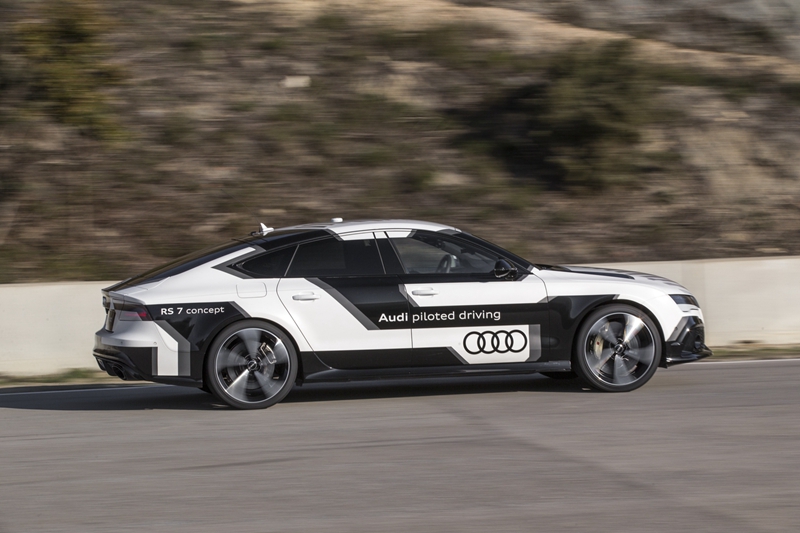 在巴塞罗纳附近的Castelloli赛道上高速驰骋的奥迪RS7跑车,作者也在车内,体验奥迪的“脱手脱脚”领航功能。
在巴塞罗纳附近的Castelloli赛道上高速驰骋的奥迪RS7跑车,作者也在车内,体验奥迪的“脱手脱脚”领航功能。 奥迪的高级到达系统(advanced arrival system)概念。
奥迪的高级到达系统(advanced arrival system)概念。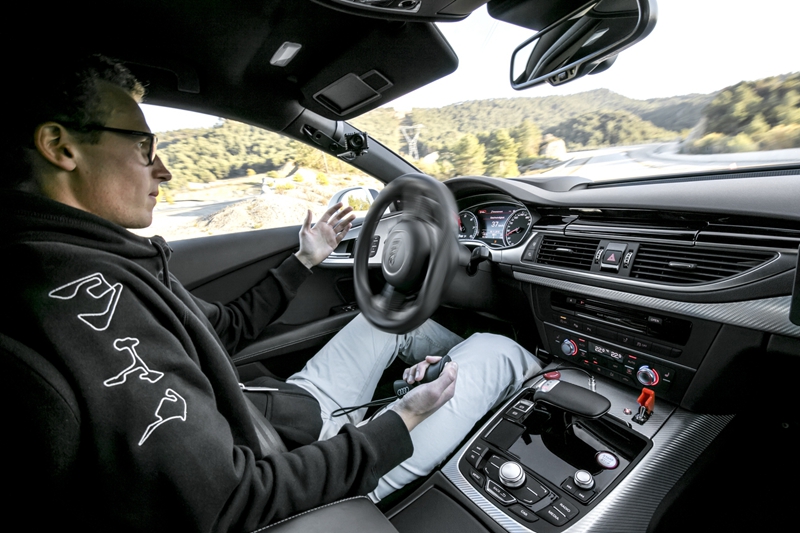 松开方向盘!奥迪领航驾驶团队的一名队员正在演示,在行驶时他并不需要控制汽车。
松开方向盘!奥迪领航驾驶团队的一名队员正在演示,在行驶时他并不需要控制汽车。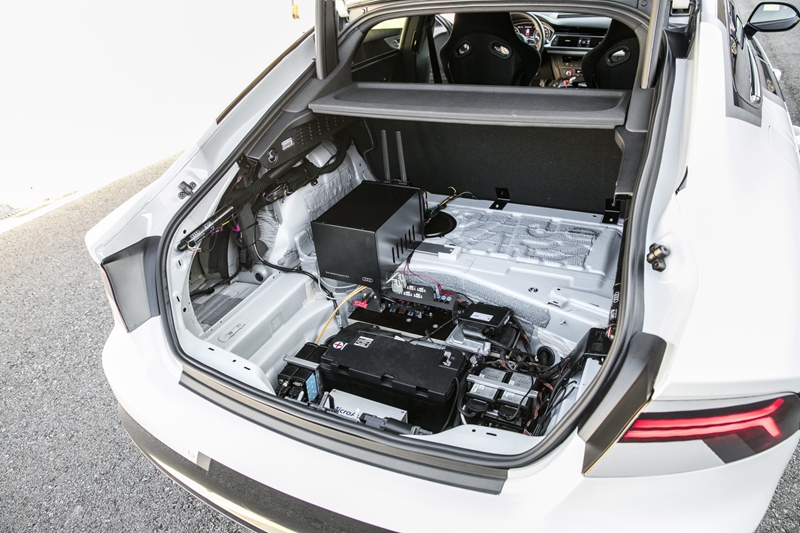 奥迪将自动驾驶系统安装在RS7测试车的后备箱中。
奥迪将自动驾驶系统安装在RS7测试车的后备箱中。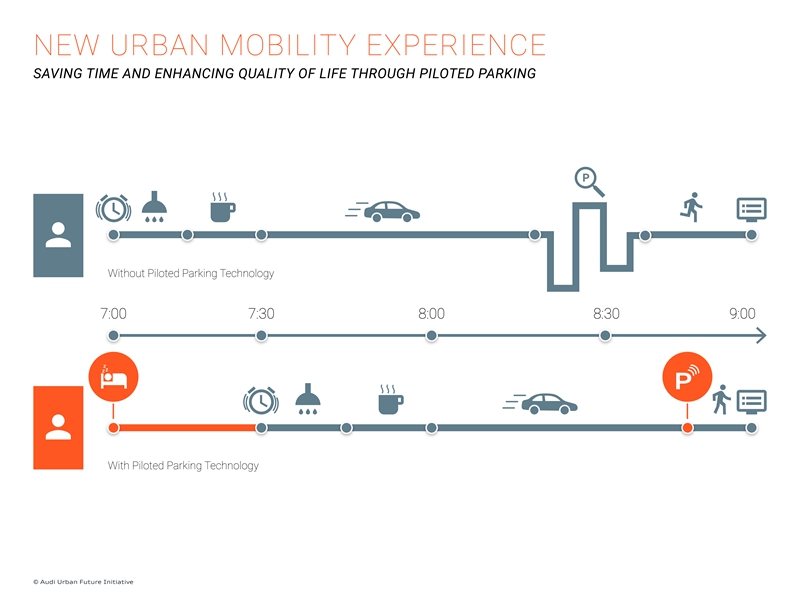 一种全新城市交通运输体验。
一种全新城市交通运输体验。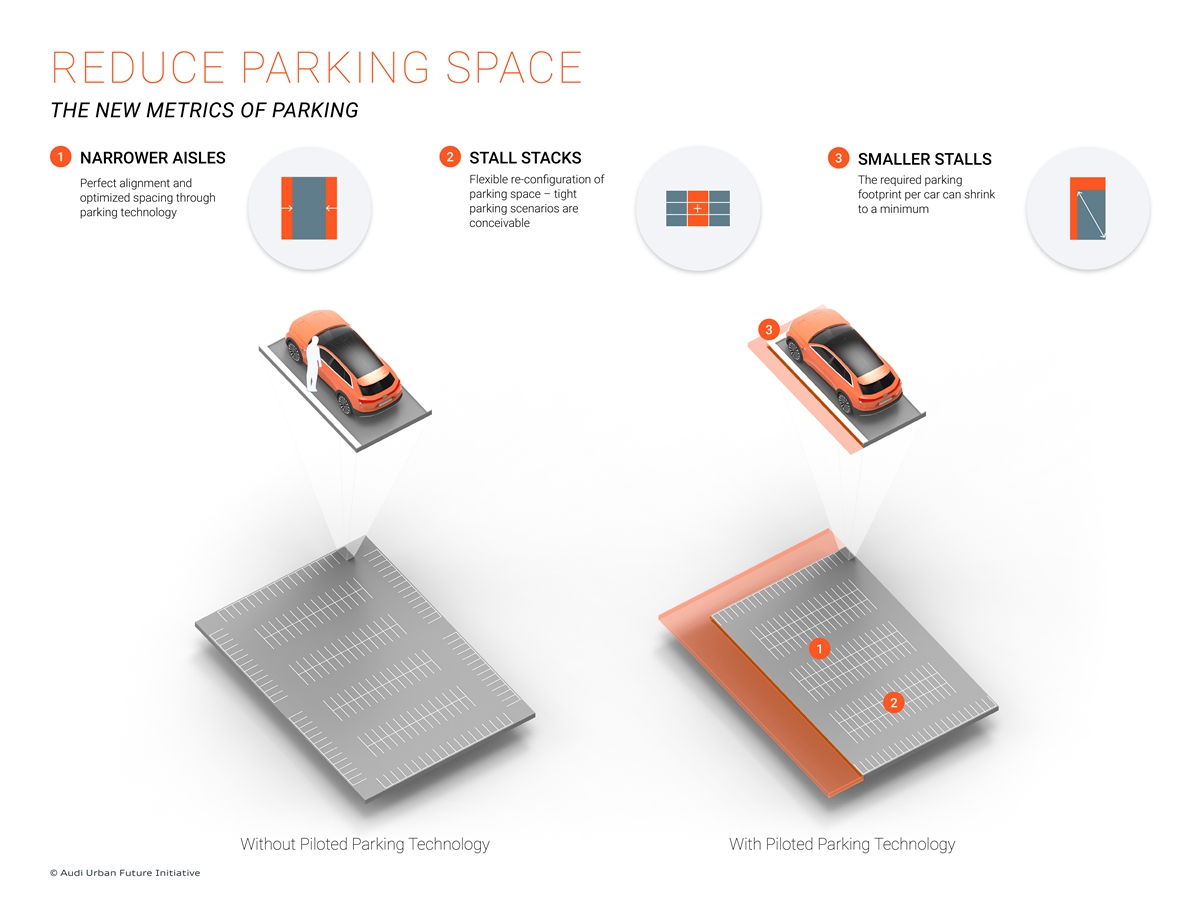 通过“领航停车”功能,可以节约停车用地。
通过“领航停车”功能,可以节约停车用地。 奥迪主席Rupert Stadler教授在向七国集团的部长们展示带有领航驾驶功能的RS7跑车。
奥迪主席Rupert Stadler教授在向七国集团的部长们展示带有领航驾驶功能的RS7跑车。
让一辆以时速210KM飞驰的大马力奥迪RS7跑车,在无人控制——“脱手脱脚”(手不在方向盘上,脚不在刹车板上)的情况在下坡赛道急转弯处紧急制动,与在车水马龙的城市中心寻找停车位自助泊车,这两件事看上去似乎是风马牛不相及。但事实上这两者之间确有关联。
这其中的联系,就是自动驾驶技术。
最近,在西班牙巴塞罗纳附近的Castelloli赛道上,奥迪总裁Rupert Stadler教授和他的专家组向包括《SAE 汽车工程杂志》在内的少数媒体展示了奥迪在自动驾驶领域的实力和一些研发项目。在现阶段,这些技术还需证明,它们不仅可以在高速行驶中避免人为错误,而且还有更大的潜力,可以为城市交通和“智能城市”的发展带来极大的便利和更低的成本。
为了证明这一点,奥迪进行了大量的投入。据Stadler介绍,“未来5年内,我们将在自动驾驶领域投资大约240亿欧元,其中70%至80%将直接用于自动驾驶技术和产品的研发。”很大程度上,自动驾驶技术和产品的进步都将为自动驾驶系统和自动驾驶车辆的未来铺平道路,而这终将为人们的出行方式带来前所未有的变革。
不过,为了实现这些潜力,汽车行业必须继续拓宽、加深各学科间的整合,现在的整合程度还远远不够。Stadler将这一过程称为“情境驱动创新(Context driven innovations)”,不但包括实现智能交通管理所必需的的交通设施和道路的设计,还涉及城市区域规划、建筑建设,以及地方和国家政府管理等方方面面的问题。要发展智能城市,这些元素都必不可少。
下一代奥迪A8能力惊人
奥迪是积极参与“智能城市”建设的先锋。这家德国汽车制造商深知城市生活的核心在于移动性,没有智能移动系统就根本谈不上智能城市。2010年,奥迪发起了“奥迪城市未来倡议(Audi Urban Future Initiative)”,旨在做好准备,以应对未来全球的新兴大都市对智能交通系统的需求。奥迪甚至在非常早期的阶段,就与数位有能力预见2050年城市面貌的优秀设计师进行了接洽。
Stadler表示,每座城市都是不同的,这对汽车行业无疑是很大的挑战,但也同时能为设计师和工程师带来更多机会。Stadler深信,能实现碳中和(CO2-neutral)交通运输方式,一定会变为现实。他断言,“这只是时间问题,当然我们需要进行正确的可行性分析。”
如果奥迪能够通过数字化技术整合所有传感器、摄像头和激光控制解决方案,推出类似自动驾驶和自动泊车的技术(奥迪为了强调驾驶员对车辆控制与安全负有最终的责任,将其称为“领航”驾驶和“领航”停车),就能为提升城市居民的生活质量做出巨大贡献。
Stadler坦言,奥迪必须寻求“合适的合作伙伴”。据预计,到21世纪中期,在很多国家,70%的人将选择步行、骑车或搭乘公共交通出行,而不是驾驶汽车。但Stadler对此并不担心。他相信,汽车,包括豪车品牌,仍将拥有自己的市场。
Stadler表示,“比如,汽车在中国就被视为‘自由的象征’。我坚信随着数字化技术的不断发展,未来各种出行方式的互联性都会有很大提升,而现在就开始开发新技术的公司,未来定会处于领先地位。”
奥迪的下一代A8可以在政策允许且拥有配套基础设施的国家内,为车主提供领航停车和自动公路驾驶功能。Stadler也已证实,奥迪的其他车型也会在2017到2018年配备类似功能。驾驶员终有一天可以直接下车,然后让汽车自己去找车位,或者停在远离繁忙城市中心的地方。
由于自动泊车并不设计乘员上下车的问题,无需打开车门,因此能停入更窄的车位之中。城市规划者认为这种技术最高可使车位面积缩小60%,从而腾出大量车位用地,以作他用。
Stadler相信,“未来的停车场里肯定有各种各样的车,并非仅有常见的城市车辆。”
大数据的作用
目前,奥迪已经参与了数个“智能城市”建设项目,其中一个位于波士顿附近的萨默维尔市。去年年底,波士顿市的市长Joseph A. Curtatone与Stadler签署了一份联合谅解备忘录,达成共识,将进行密切合作,为萨默维尔市联合广场 (Union Square) 区域设计全新的交通运输布局。Stadler表示,“我们希望能够提出一个新的城市概念,为日后的智能城市发展提供蓝图。”
Stadler认为,这份合约将带领奥迪进入一个全新的王国,这在过去可能会让人觉得荒诞可笑,但是,这却是奥迪,甚至整个汽车行业必须前进的方向。
他表示,“由于汽车会造成交通阻塞,浪费宝贵的时间,因此部分民众认为,汽车已不再是适合城市生活的智能解决方案。事实上,通过我们的解决方案,汽车将达到前所未有的‘智能’水平。”奥迪认为,如果能实现“消除汽车在行驶和停放时对城市带来的影响”这一战略目标,个人出行将成为一件乐事,而不是一种负担。
Stadler解释说,在传统行业中,体量越大,占据的市场份额就越大。但在网络或平台的概念中,情况正好相反:“大数据就是一种集合大量信息,从而达到精确结论的过程,参与者越多,服务水平和市场接受度就越高。目前,汽车仍属于传统行业,但我们将逐步将其转变为通过平台扩张的模式。”Stadler如是说。
去年,奥迪联合梅赛德斯-奔驰(Mercedes-Benz)和宝马(BMW),一起从诺基亚(Nokia)收购了数字地图公司HERE。这几家公司希望能向所有对象开放这个数字地图平台,其中也包括各个城市。
他表示,群体智能(swarm intelligence)将“改变城市的面貌和行为”,“有人认为城市化会将驾驶车辆的出行方式带入死胡同,我却认为城市化将会开启未来智能交通运输系统的发展之门。”
但是,实现这一点的前提是汽车自动驾驶技术必须足够可靠,在各种环境下,无论是高速公路上,还是超低速行驶的城市街道中,抑或是拥挤的停车场中,均能正常工作。
这就是驰骋赛道的自动驾驶RS7跑车与自动停车功能之间的联系——自动驾驶技术。依靠这一技术,车辆在任何大城市中,无论面对怎样复杂的交通环境,都能安全地完成停车任务。
作者:Stuart Birch
来源:SAE 《汽车工程杂志》
翻译:SAE 上海办公室
Why Audi boss Stadler believes in a hands-off future
Braking a 412-kW (552-hp) lightened Audi RS7 very hard from 210 km/h (130 mph) deep into a downhill tight corner on a racetrack—with feet off the pedals and hands off the steering wheel—may seem to have little connection with parking in a traffic-thronged city center. But it has.
The link is autonomous driving technology.
To make the point, Audi Chairman Prof. Rupert Stadler and his specialist teams recently demonstrated their company's capabilities and R&D programs in the automated/autonomous arena to select media, including Automotive Engineering, at the Castelloli circuit near Barcelona. These technologies are now proving their potential not only to take human error out of high speed travel but to bring significant convenience and cost benefits to urban transport and the development of “smart” cities.
Audi is committing the financial resources to prove it. “In the next five years we will invest probably 24 billion euros, with 70-80% directed to technology and product,” Stadler explained. A large proportion of both will pave the way toward systems and vehicles that will deliver mobility on a different digital level to anything available today.
But to see the potential fulfilled will require the auto industry to widen and deepen its integration with disciplines that until now have been way outside its immediate ambit. Stadler calls them “context driven innovations” and they include not just transport infrastructure and highway engineering to achieve intelligent traffic management, but also urban area planning and even architecture, together with local and national government administrations. It all adds up to smart city development.
Next A8 capabilities
Audi is a pioneer in anticipating this. In 2010 it launched the Audi Future Initiative to help prepare for the transport needs of a burgeoning global metropolis landscape, in the knowledge that there could be no smart city without a smart mobility system because mobility is at the core of urban life. Even at that early stage, connections were made with leading architects who could envisage how cities would look by 2050.
A challenge, though, for the auto industry is that every city is different but, stated Stadler, that brought more opportunity than threat for designers and engineers. He is confident that CO2-neutral mobility will become a fact. “It is only a matter of time and of completing the right feasibility work,” he asserted.
If Audi is in the position to offer the right technologies like autonomous driving and parking (the company calls it “Piloted” driving and parking to emphasize the driver's ultimate responsibility for vehicle control and safety) via digitalization, incorporating sensor control, cameras and laser solutions, it could offer a major contribution to improving quality of life for urban dwellers.
Audi will need to connect “with the right partners," Stadler admitted. He is not concerned that by mid-21st century 70% of the population of many countries are estimated to be city dwellers that may walk, cycle, and use public transport rather than cars. He is confident that cars, including premium brands, will continue to be in demand.
"For example, in China, car ownership is 'a symbol of freedom.' I am absolutely convinced that with new digitalization technologies there will be a much better connectivity of different sorts of mobility—and those who try to get into it now will be in first place,” he said.
The next generation A8 will incorporate both piloted parking and autonomous highway driving capability in countries that permit such technologies and have required infrastructure support. Other models will follow in 2017-18, he confirmed. Eventually a driver would be able to step out of a car and allow it to find its own parking space or to park away from a busy city center.
Such technology provides the opportunity for much narrower parking bays, as no access to a vehicle’s interior would be required. City planners see this capability reducing parking space required by up to 60%, he explained, freeing up real estate use for other purposes.
“There will be a broad spectrum of models in those car parks, not just city cars,” believes Stadler.
The role of Big Data
Audi is involved in several “smart city” schemes, one of them at Somerville City near Boston. Late last year Boston Mayor Joseph A. Curtatone and Stadler signed a joint Memorandum of Understanding (MoU) agreeing close co-operation in developing a new mobility strategy for the city’s Union Square area: “We plan to develop an urban concept that serves as a blueprint for smart cities of the future,” Stadler said.
The agreement is one that takes Audi into a realm that would once have been considered laughable but it's the way the company, and the industry, must move, believes Stadler.
“Some people don’t consider cars to be a smart solution in cities anymore, causing traffic jams and costing precious time. In fact with our new solutions, the car will reach a totally new level of being ‘smart', he said. In Audi's vision, individual mobility becomes the source of social benefits, rather than costs, with the strategic goal of "removing the urban footprint of cars, both moving and parked."
Stadler argues that in traditional business, high quality leads to a high segment share. But in a network or platform logic, it's the other way round: "Big data is a condition for precise information and more participants lead to a better service level and market acceptance. So far, the car industry is a traditional business but step by step we will turn it into a platform business,” he pledged.
Audi, together with Mercedes-Benz and BMW last year bought the digital mapping company HERE from Nokia. The companies want the platform to stay open to others, including cities.
He stated that swarm intelligence would “change the face and motion” of cities: “Some say that urbanization is the dead-end to individual auto mobility. I say that it’s a trigger to a smart future mobility system.”
But autonomous cars have to be as utterly dependable and trusted to operate on fast highways, ultra-low speed city streets, and in densely packed car parks.
So that is why there is a link between a robot hurling an RS7 round a 4.1-km (2.5-mi), 13-corner racetrack and, eventually, a car that will safely obey orders in the traffic maelstrom of any city in the world.
Author: Stuart Birch
Source: SAE Automotive Engineering Magazine
等级
打分
- 2分
- 4分
- 6分
- 8分
- 10分
平均分
